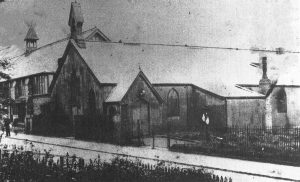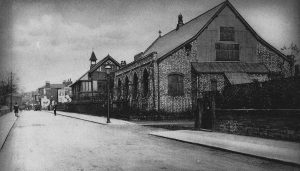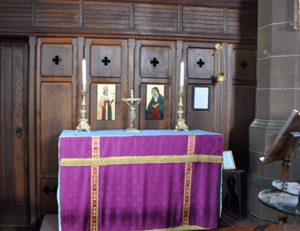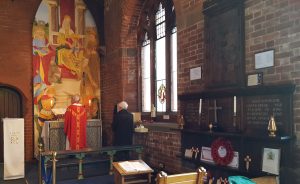St Hilda’s Church Prestwich – A short history.
![]() The history of St Hilda began over 200 years ago with the construction of a Day School which stood on the site of the Station Lodge entrance to Heaton Park. The school was led by a single School Master and served a large area with children travelling long distances. In 1816 moves were made to establish National Schools and so the following year the children were transferred from St Hilda’s, or Rooden Lane as it was called in those days, to Prestwich.
The history of St Hilda began over 200 years ago with the construction of a Day School which stood on the site of the Station Lodge entrance to Heaton Park. The school was led by a single School Master and served a large area with children travelling long distances. In 1816 moves were made to establish National Schools and so the following year the children were transferred from St Hilda’s, or Rooden Lane as it was called in those days, to Prestwich.
Twenty years later it was considered necessary for the growing district to have an Infant’s School and so one was opened in Infant’s Street in 1840 by the generosity of the Earl of Wilton and it remained in his patronage until 1871 when it was handed to the care of the National Schools. This continued until 1879 when, due to a lack of accommodation for both Day and Sunday Scholars, it was necessary to build the present school on Whittaker Lane. The new building was opened by the Countess of Wilton on 29th November 1879 and was designed to cater for both school purposes but also, at the East end, to have a Chancel.
The Reverend Thomas Davies was appointed to the Curate of Prestwich in 1879 and lived in Bent Lane. He believed that the religious instruction of the children was seriously lacking outside of the Day School and decided to use the Infant Street building once again as a Sunday School and soon had over 60 Scholars attending each week. At the end of 1870 there were recorded 183 scholars and 23 teachers. This steadily grew until it was transferred to the Whittaker Lane school in 1879.
In 1887 The Reverend H.S. Fawssett was put in charge of the District and a temporary ‘Iron Church’ was constructed adjoining the school. The Chancel Fixtures were transferred from the school and the ancient Font which had been in the Parish Church until 1854 was renovated and moved to the Iron Church. This structure had not long been in place before it was enlarged and could provide seating for 260 worshippers.
 The Iron Church became the spiritual home of the people of the district, but eventually a permanent Church was considered a necessity. The first steps were taken at a meeting held on Saturday 27th February 1897 where a committee was formed to raise the necessary funds. Fund raising, as is always the case, proved a challenge but money started to slowly come in.
The Iron Church became the spiritual home of the people of the district, but eventually a permanent Church was considered a necessity. The first steps were taken at a meeting held on Saturday 27th February 1897 where a committee was formed to raise the necessary funds. Fund raising, as is always the case, proved a challenge but money started to slowly come in.
It was during this period that Canon Cooper was appointed as the new Rector of Prestwich in February 1900 and the Reverend W.M. Hump was appointed to the Charge of the Whittaker Lane district. Despite this sudden change of leadership, great enthusiasm was maintained and the effort to raise funds for the new church were redoubled by the arrival of the new clergy. Mr F.P. Oakley, an architect from Manchester, drew up plans and the work began.
The foundation stone of the present church was laid by Canon Cleworth of Middleton. The stone bears the inscription:
‘To the Glory of God and in memory of Saint Hilda, Abbess of Whitby, famous among the Master Builders of the Catholic Church in this land, the foundation stone of this Church, dedicated in her name was dedicated on the 3rd day of October, 1903’
 The main portion of the building was completed, and on Saint Luke’s Day, 18th October 1904, the Church was consecrated by the Lord Bishop of Manchester, The Right Reverend Dr Edmund Knox. The west end and vestry were of a temporary construction and remained so until 1922, at which year, the current vestries, the War Memorial Lady Chapel and installation of electric lighting were completed and were dedicated by The Right Reverend Dr William Temple, Lord Bishop of Manchester, who went on to be Archbishop of York.
The main portion of the building was completed, and on Saint Luke’s Day, 18th October 1904, the Church was consecrated by the Lord Bishop of Manchester, The Right Reverend Dr Edmund Knox. The west end and vestry were of a temporary construction and remained so until 1922, at which year, the current vestries, the War Memorial Lady Chapel and installation of electric lighting were completed and were dedicated by The Right Reverend Dr William Temple, Lord Bishop of Manchester, who went on to be Archbishop of York.
A boundary wall and carved oak gates were added and a permanent West end structure, with North and South porches and Baptistry were added. The main fabric of the building has remained unchanged and continues to provide a place for those of the Anglo-Catholic tradition of the Church of England. The Croft (the new hall) marks a new beginning and a great opportunity to build on the faith and determination of those who brought this Church into being and is part of our legacy for the future.
The High Altar
As with most churches the High Altar in St Hilda’s is at the east end of the building.
The altar is surmounted by a beautiful screen called a ‘reredos’ and depicts the visit of the Three Wise Men and shows Our Blessed Lady cradling the infant Christ Child.
The screen was given to the church in 1916 by Edith Anderson in memory of her late husband.
The Memorial Chapel
 The altar is surmounted by two beautiful icons of St Thomas of Canterbury and the Virgin Mary. These, together with the pricket stand, were donated to St Hilda’s by Tony Frost in memory of his parents, Bernard and Lily Frost.
The altar is surmounted by two beautiful icons of St Thomas of Canterbury and the Virgin Mary. These, together with the pricket stand, were donated to St Hilda’s by Tony Frost in memory of his parents, Bernard and Lily Frost.
The Lady Chapel
The Lady Chapel was dedicated in 1922, soon after St Hilda’s became a Parish Church in its own right.
 The painting behind the altar of the Virgin and Child with supporting saints incorporates local scenes such as the gates to Heaton Park. In the same year the Baptistery, at the West End of the church, was also installed and consecrated.
The painting behind the altar of the Virgin and Child with supporting saints incorporates local scenes such as the gates to Heaton Park. In the same year the Baptistery, at the West End of the church, was also installed and consecrated.
The Nave
Originally the centre of the church had pews which had become old and dilapidated. Recently the seating for the congregation has been changed and we now have comfortable upholstered chairs that have been very much appreciated by the congregation and our many visitors.